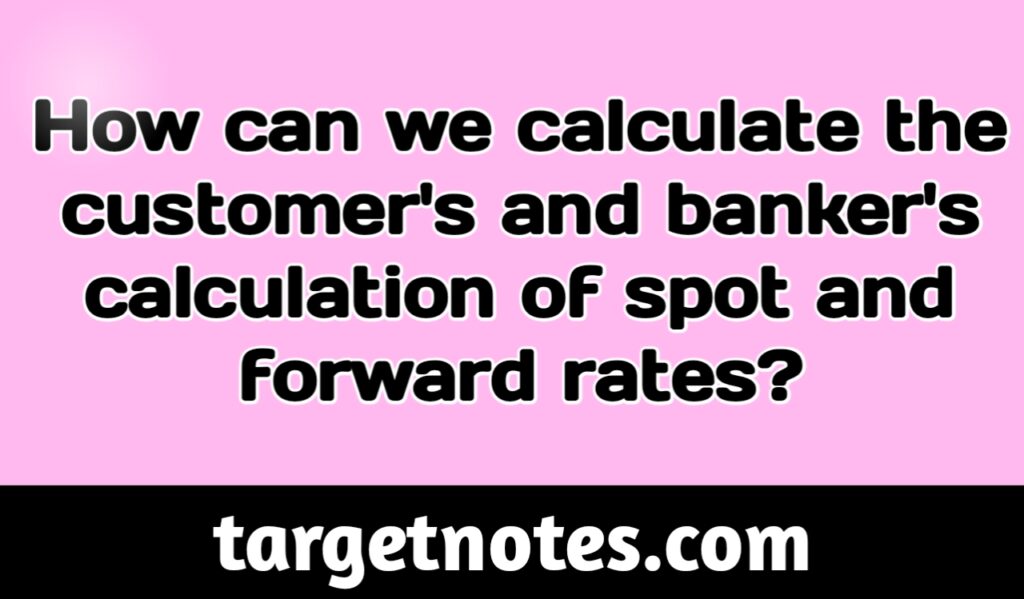
Contents
How can we calculate the customer’s and banker’s calculation of spot and forward rates?
Exchange Rate Calculations
Foreign exchange contracts are for “cash” or “ready” delivery which means delivery same day, “value next day” which means delivery next business day and “spot” which is two business days ahead. For forward contracts, either the delivery date may be fixed in which case the tenor is computed from the spot value date or it may be an option forward in which case delivery may be during a specified week or fortnight, in any case not exceeding one calender month.
Till August 2, 1993, exchange rate quotations in the wholesale, (i.e., interbank market) used to be given as indirect quotations, i.e., units of foreign currency per Rs. 100. Since then, the market has shifted to a system of direct quotes given as rupees per unit (or per 100 units) of foreign currency, with the bid rate referring to the market maker buying the foreign currency and the offer rate being the market maker’s rate for selling the foreign currency. We are already familiar with this way of quoting exchange rates.
The rates quoted by banks to their non-bank customers are called “Merchant Rates”. Banks quote a variety of exchange rates. The so called TT rates (the abbreviation TT denotes “Telegraphic Transfer”) are applicable for clean inward of outward remittances, i.e., the bank undertakes only currency transfers and does into have to perform any other function such as handling documents. For instance, suppose an individual purchases from Citi Bank in New York a demand draft for $ 2000 drawn on Citi Bank Mumbai. The New York bank will credit the Mumbai bank’s account with itself immediately. When the individual sells the draft to Citi Bank Mumbai, the bank will buy the dollars at its TT Buying Rate. Similarly, TT Selling Rate is applicable when the bank sells a foreign currency draft or MT. TT buying rate also applies when an exporter asks the bank to collect an export bill and the bank pays the exporter only when it receives payment from the foreign buyer as well as in cancellation of forward sale contracts. (In these cases there will be additional flat fees).
When there is some delay between the bank paying the customer and itself getting paid, e.g., when the bank discounts export bills, various margins are subtracted from the TT buying rates. Similarly, on the selling side, when the bank has to handle documents, etc., apart from effecting the payment, margins are added to the TT selling rate. The margins are subject to a ceiling specified by the FEDAI (Foreign Exchange Dealers’ Association of India) though a bank can charge less. All this is best illustrated by some examples. We will explain the principles of rate computation in the text; several worked examples can be found in the appendix to this chapter.
TT Buying Rate:
This rate is calculated as:
TT Buying Rate = A Base Rate – Exchange Margin
The “base rate” is the interbank rate. Thus suppose the interbank bid rate for US dollars is Rs. 35.25. The bank wants exchange margin of 0.125% the TT buying rate would be:
(35.25) (1 -0.00125)= 35.2109 rounded off to 35.20.
Thus if a draft for $10,000 is cashed by the bank where its overseas account has already been credited, it will give
Rs. [35.20 x 10000] = Rs. 3,52,000
When cashing a personal cheque or a banker’s cheque payable overseas, the bank will not give this rate because it has to send the cheque overseas for collection. This means a delay which is called transit period. The bank will further subtract an exchange margin from the TT buying rate and also recover interest from the customer for the transit period. The transit periods for various countries are specified by the FEDAI and the interest rate to be charged is specified by the RBI. The purpose of the exchange margin is to recover the costs involved and provide a profit margin to the bank.
Bill Buying Rate:
Exporters draw bills of exchange on their foreign customers. They can sell these bills to an AD for immediate payment. The AD buys the bill and collects payment from the importer. Since there is delay between the AD paying the exporter and itself getting paid, various margins have to be subtracted from the TT buying rate to compute the bill buying rate.
Bills are of two kinds. Sight or demand bills require payment by the drawee on presentation. The delay involved in such a bill is only the transit period. Time or usance bills give time to the importer to settle the payment, i.e., the exporter has agreed to give credit to the importer. In such cases the delay involved is transit period plus the usance period.
In addition to the exchange margin to cover costs and provide profit, the AD will now load the forward margin for an appropriate period. The period for which forward margin is to be loaded depends upon whether the foreign currency is at a forward discount or premium. The principle is that the AD will extract the rate which is most favourable to itself. The rate computation formula is laid out below.
Bill Buying Rate
Bill Buying Rate = The base rate – Forward discount for transit plus usance period rounded off to the higher month – Exchange Margin
OR
= The base rate + Forward premium for transit plus usance
period rounded off to the lower month – Exchange Margin
In addition, the bank is entitled to recover from the customer, interest for the transit plus usance period. The use of this formula is illustrated by some examples worked out in the appendix to this chapter.
TT Selling Rate
This rate is computed as follows:
TT Selling Rate = A Base Rate + Exchange Margin
The base rate here is the interbank selling rate. As usual, the exchange margin is subject to a ceiling specified by the FEDAI. Thus suppose a customer wishes to purchase a draft drawn on London for £10,000. The interbank £/Rs selling rate is Rs. 55.50/£. The bank wants an exchange margin of 0.15%. The TT selling rate would be
55.50 (1 + 0.0015) = 55.5832 rounded off to Rs. 55.58.
The customer will have to pay
Rs. [10000 x 55.58] = Rs. 5,55,800
apart from any other bank charges.
Bill Selling Rate:
When an importer requests the bank to make a payment to a foreign supplier against a bill drawn on the importer, the bank has to handle documents related to the transaction. For this, the bank loads another margin over the TT selling rate to arrive at the Bill Selling Rate. Thus
Bill Selling Rate = TT Selling Rate + Exchange Margin
Some worked examples in the appendix illustrate the calculation of bill selling rates.
Forward rates are computed by subtracting the appropriate discounts or adding the premia from the relevant spot rate. Margins are loaded as in the case of spot rates. The rate computation formulas are laid out below. Numerical examples can be found in the appendix.
(In the case of forward buying, forward period, usance period and transit period are to be added together. Thus for a 30-day bill bought 2 months forward, with transit period of 15 days, the total comes to 60 30+ 15, i.e., 105 days. If the currency is at discount bank will take discount for 120 days; if at premium it will give premium for 90 days).
Forward Buying Rate
Forward Buying Rate = Spot Rate – Forward Discount for Transit plus Usance plus forward period rounded off to the Higher Month Exchange Margin.
OR
= Spot Rate + Forward Premium for Transit plus usance plus forward period rounded off to the Lower Month – Exchange Margin.
Forward Selling Rate
Forward TT Selling Rate = Interbank Spot Selling Rate Forward Discount for Forward Period + Exchange Margin.
OR
= Interbank Spot Selling Rate + Forward Premium for Forward Period + Exchange Margin
Forward Bill Selling Rate = Forward TT Selling Rate + Exchange Margin for Bill Selling
Computations of cross rates are done in the usual manner. In some cases, quotes against rupee may not be available in the Indian interbank market. The bank then has to base its quotation on rates available in a foreign centre such as London or Singapore. For instance, suppose a customer whishes to buy Spanish peseta. The bank will synthesize a quote based on the ESP/USD rate from the London market and the INR/USD rate in the Mumbai market. If INR/USD selling rate is say 35.50 and ESP/USD bid rate is 110.00, then the INR/ESP offer rate will be 32.27 (Rs. per 100 pesetas).
Banks often undertake swap transactions among each other to square up their positions arising out of their transactions with customers..
IMPORTANT LINK
- What is the Exchange Rate System in India?
- Evolution of foreign exchange market in India
- Meaning and importance of export finance.
- Role of Export-Import Bank in Financing India’s Foreign Trade
- How Commercial banks Export Finance to Overseas Importers?
- Explain packing credit in detail?
- What is Post-shipment credit?
- What is Pre-shipment or packing credit?
- Explain Export Credit in India?
- Institutions Providing Finance and Credit Facility for Foreign Trade
- What is Risk Analysis?
- Explain Political risks in detail? and its Types
- What are the types of Risks. Explain in detail?
- Meaning and Types of commercial risks
- How can we minimize foreign trade risks?
- What are Arbitrage operations?
- Difference between Spot Market and Forward Market
- What is spot exchange?
- Agency agreement: Meaning, Features and Advantages
- Functions of Foreign Exchange markets
- structure of Foreign exchange markets
Disclaimer






